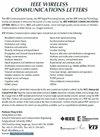Hybrid LLM-DDQN-Based Joint Optimization of V2I Communication and Autonomous Driving
IF 5.5
3区 计算机科学
Q1 COMPUTER SCIENCE, INFORMATION SYSTEMS
引用次数: 0
Abstract
Large language models (LLMs) have received considerable interest recently due to their outstanding reasoning and comprehension capabilities. This letter explores applying LLMs to vehicular networks, aiming to jointly optimize vehicle-to-infrastructure (V2I) communications and autonomous driving (AD) policies. We deploy LLMs for AD decision-making to maximize traffic flow and avoid collisions for road safety, and a double deep Q-learning algorithm (DDQN) is used for V2I optimization to maximize the received data rate and reduce frequent handovers. In particular, for LLM-enabled AD, we employ the Euclidean distance to identify previously explored AD experiences, and then LLMs can learn from past good and bad decisions for further improvement. Then, LLM-based AD decisions will become part of states in V2I problems, and DDQN will optimize the V2I decisions accordingly. After that, the AD and V2I decisions are iteratively optimized until convergence. Such an iterative optimization approach can better explore the interactions between LLMs and conventional reinforcement learning techniques, revealing the potential of using LLMs for network optimization and management. Finally, the simulations demonstrate that our proposed hybrid LLM-DDQN approach outperforms the conventional DDQN algorithm, showing faster convergence and higher average rewards.基于混合LLM-DDQN的V2I通信与自动驾驶联合优化
大型语言模型(llm)由于其出色的推理和理解能力,最近受到了相当大的关注。这封信探讨了将llm应用于车辆网络,旨在共同优化车辆到基础设施(V2I)通信和自动驾驶(AD)政策。我们部署llm进行AD决策,以最大限度地提高交通流量并避免道路安全的碰撞,并使用双深度q -学习算法(DDQN)进行V2I优化,以最大限度地提高接收数据速率并减少频繁的切换。特别是,对于支持llm的AD,我们使用欧几里得距离来识别以前探索过的AD经验,然后llm可以从过去的好决策和坏决策中学习,以进一步改进。然后,基于llm的AD决策将成为V2I问题中状态的一部分,DDQN将相应地优化V2I决策。之后,迭代优化AD和V2I决策,直到收敛。这种迭代优化方法可以更好地探索llm与传统强化学习技术之间的相互作用,揭示了使用llm进行网络优化和管理的潜力。最后,仿真结果表明,我们提出的混合LLM-DDQN方法优于传统的DDQN算法,具有更快的收敛速度和更高的平均奖励。
本文章由计算机程序翻译,如有差异,请以英文原文为准。
求助全文
约1分钟内获得全文
求助全文
来源期刊

IEEE Wireless Communications Letters
Engineering-Electrical and Electronic Engineering
CiteScore
12.30
自引率
6.30%
发文量
481
期刊介绍:
IEEE Wireless Communications Letters publishes short papers in a rapid publication cycle on advances in the state-of-the-art of wireless communications. Both theoretical contributions (including new techniques, concepts, and analyses) and practical contributions (including system experiments and prototypes, and new applications) are encouraged. This journal focuses on the physical layer and the link layer of wireless communication systems.
 求助内容:
求助内容: 应助结果提醒方式:
应助结果提醒方式:


